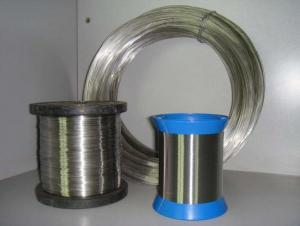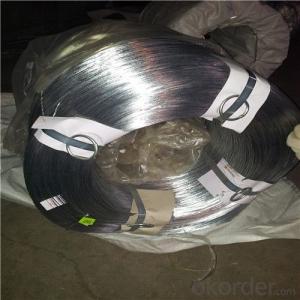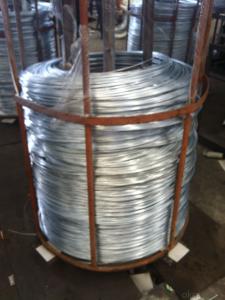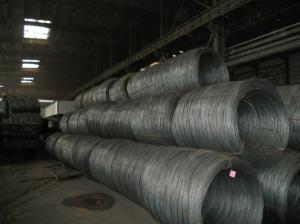Wire Galvanized Steel Wire Rod for ACSR
- Loading Port:
- Qingdao
- Payment Terms:
- TT OR LC
- Min Order Qty:
- 10 m.t.
- Supply Capability:
- 50000 m.t./month
OKorder Service Pledge
OKorder Financial Service
You Might Also Like
Specification
Wire Galvanized Steel Wire Rod for ACSR
Description
1. Material: Q195,Q235,45#,60#,65#,70#,72B,80#,82B,65Mn
2. Surface Coating: Galvanized
3. Characteristic: High tensile strength,small tolerance
Shiny surface, good corrosion prevention
4. Packing type:Spool or Coil
5. Application: Being used for stranded conductors in overhead power circuitry
6. Remarks during use and handling:
a. During transportation, handle softly and carefully, avoid bumping and damaging the steel wires. Moisture and rain prohibited. Steel wires must be stored in dry and well ventilated indoors
b. Pay attention to the direction of steel wires when paying-off. Be sure the spool or coil is rotating freely as to achieve identical tension of all the steel wires
c. In case of batch usage, the remaining should be repacked to avoid oxidizing of the surface
Technical Parameters
Wire dia: 1.24-5.5mm; Tensile Strength:1290~1340Mpa
Nominal diameter (mm) | Tensile Strength | Stress at 1% Elongation | Twist | Elongation | Standard |
mm | Mpa | Mpa | Times/360° | Lo=250mm | |
1.24~2.25 | ≥1340 | ≥1170 | ≥18 | ≥3.0% | As per GB,EN,IEC,JIS,ASTM standard, as well as customer's request |
2.25~2.75 | ≥1310 | ≥1140 | ≥16 | ≥3.0% | |
2.75~3.00 | ≥1310 | ≥1140 | ≥16 | ≥3.5% | |
3.00~3.50 | ≥1290 | ≥1100 | ≥14 | ≥3.5% | |
3.50~4.25 | ≥1290 | ≥1100 | ≥12 | ≥4.0% | |
4.25~4.75 | ≥1290 | ≥1100 | ≥12 | ≥4.0% | |
4.75~5.50 | ≥1290 | ≥1100 | ≥12 | ≥4.0% |
Packaging & Delivery
Packaging Details: | Coil with plastic outside or according to customer's requirement. |
Delivery Detail: | 20 working days after receiving your order. |
Products Show


- Q: Can stainless steel wire be used for wire hangers?
- Certainly, wire hangers can utilize stainless steel wire. The use of stainless steel is highly favored when it comes to wire hangers because of its enduring nature, robustness, and ability to withstand corrosion. These exceptional characteristics render stainless steel wire hangers highly durable and appropriate for suspending a wide array of garments. Moreover, in comparison to hangers crafted from alternative materials, stainless steel wire hangers are notably less prone to leaving unsightly rust marks on clothing.
- Q: Can stainless steel wire be used for wire rope sheaves?
- Yes, stainless steel wire can be used for wire rope sheaves. Stainless steel is known for its excellent corrosion resistance, durability, and strength, making it a suitable material for various applications, including wire rope sheaves. Stainless steel wire rope sheaves are commonly used in industries such as marine, oil and gas, construction, and lifting equipment, where they are exposed to harsh environments or corrosive substances. The corrosion resistance of stainless steel helps prevent rust and degradation, ensuring the longevity and reliability of wire rope sheaves. Additionally, stainless steel wire offers high tensile strength, providing the necessary load-bearing capacity for wire rope systems. Overall, using stainless steel wire for wire rope sheaves is a practical choice for ensuring optimal performance and longevity in various industrial applications.
- Q: Can stainless steel wire be easily soldered or welded?
- Stainless steel wire can be both soldered and welded, but the ease of doing so may vary depending on the specific type of stainless steel and the skill level of the person performing the soldering or welding. Soldering stainless steel wire can be challenging because it has a high melting point and is resistant to corrosion. However, with the right tools and techniques, it is possible to solder stainless steel wire. It is important to use a soldering iron with enough power to heat the stainless steel wire properly and to choose a soldering flux specifically designed for stainless steel. Additionally, the wire should be thoroughly cleaned and properly prepared before attempting to solder it. Welding stainless steel wire, on the other hand, is generally easier than soldering. Stainless steel wire is commonly welded using either TIG (Tungsten Inert Gas) welding or MIG (Metal Inert Gas) welding techniques. TIG welding is particularly suitable for thin wires and precise welds, while MIG welding is more commonly used for thicker wires and larger-scale projects. In summary, while soldering stainless steel wire can be more challenging due to its high melting point and corrosion resistance, it is still possible with the right tools and techniques. On the other hand, welding stainless steel wire is generally easier and can be accomplished using TIG or MIG welding techniques.
- Q: Can stainless steel wire be welded?
- Yes, stainless steel wire can be welded. Stainless steel is known for its excellent welding characteristics and is commonly welded using various processes such as TIG (tungsten inert gas), MIG (metal inert gas), and spot welding. However, it is important to note that stainless steel has different grades, and some grades may require specific welding techniques or filler materials. It is always recommended to consult the manufacturer's guidelines or a welding professional to ensure proper welding procedures are followed for the specific grade of stainless steel wire being used.
- Q: The difference between high gloss wire drawing and stainless steel drawing panel
- High light refers to stainless steel, stainless steel surface fineness reflective processing, and of course materials and postprocessing are involved, the simple point is like a mirror or silver surface like stainless steel, used for decoration, luxury door handrails, etc.,
- Q: Is the tire steel wire stainless steel?
- Tire steel wire is a high carbon steel 70-80C-90C drawn after the surface of brass plating, and then stretched into a rope, the surface is brass, thin about 0.5um, will soon rust, but and rubber will occur vulcanization reaction,
- Q: What are the different types of stainless steel wire ropes used in cranes?
- Cranes commonly utilize various types of stainless steel wire ropes. Here are some examples: 1. The 7x7 Stainless Steel Wire Rope consists of seven strands, each comprising seven wires. It offers a balance between strength and flexibility, making it suitable for overhead cranes and similar applications that require both qualities. 2. Similar to the 7x7 construction, the 7x19 Stainless Steel Wire Rope has 19 wires in each strand. It provides better flexibility and is commonly used when the wire rope needs to bend around pulleys or sheaves. 3. The 6x19 Stainless Steel Wire Rope features six strands, each made up of 19 wires. It offers a favorable combination of strength and flexibility, catering to a wide range of crane applications. 4. For heavy-duty lifting applications, such as in large overhead cranes or gantry cranes, the 6x36 Stainless Steel Wire Rope is often preferred. It consists of six strands, each containing 36 wires, providing excellent strength. 5. The 1x19 Stainless Steel Wire Rope is characterized by a single strand with 19 wires. It offers high strength and minimal flexibility, making it suitable for tower cranes and applications that require a rigid and stable rope. These examples illustrate the diversity of stainless steel wire ropes used in cranes. Choosing the appropriate wire rope depends on factors like the specific application, load requirements, and environmental conditions. Careful selection ensures the safe and efficient operation of the crane.
- Q: What is called oil film wiredrawing stainless steel?
- The original stainless steel wire drawing, adding oil film technology, the formation of a thin film on the surface of stainless steel, stainless steel can show that the change is very smooth, mainly beautiful, dustproof, oil, waterproof, easy to clean, take care of!
- Q: What are the different types of stainless steel wire ropes used in agriculture?
- In agriculture, there exists a variety of stainless steel wire ropes that serve different purposes and possess distinct characteristics. 1. The 6x19 Class Wire Rope, for instance, is composed of 6 strands, with each strand containing 19 wires. It finds its common usage in agricultural activities like fencing, vineyard trellising, and orchard support. Thanks to its strength and flexibility, it can handle heavy loads and provide stability. 2. Similarly, the 7x19 Class Wire Rope also consists of 7 strands with 19 wires in each. It offers increased flexibility and is often employed in agricultural machinery and equipment, such as pulley systems and winches. Due to its durability and versatility, it is well-suited for various agricultural operations. 3. In contrast, the 1x19 Class Wire Rope is constructed using a single strand tightly wound with 19 wires. It is frequently utilized in agricultural applications that require both high strength and minimal stretch, such as animal enclosures and livestock handling equipment. Its rigid structure ensures stability and reliability. 4. Another type of wire rope is the 7x7 Class Wire Rope, which consists of 7 strands, each containing 7 wires. It is commonly found in agricultural activities that necessitate moderate strength and flexibility, such as greenhouse construction, shade netting, and crop support systems. Its pliable nature allows for easy installation and adjustment. 5. Lastly, the 7x19 Vinyl Coated Wire Rope is coated with vinyl, providing an additional layer of protection against corrosion and wear. It is extensively used in agricultural applications that demand resistance to harsh weather conditions, for example, outdoor fencing, animal enclosures, and trellis systems. The vinyl coating also aids in reducing potential damage to crops or livestock. To ensure the appropriate selection of stainless steel wire rope for agricultural purposes, several factors must be considered, including load requirements, environmental conditions, and desired flexibility.
- Q: What are the different types of stainless steel wire rope grips?
- For various applications, there is a range of stainless steel wire rope grips available. These grips are utilized to securely fasten and hold wire ropes together, ensuring a dependable and stable connection. The assortment of stainless steel wire rope grips includes: 1. U-bolt wire rope grips: Consisting of a U-shaped bolt encircling the wire rope and a saddle fitting over the bolt, these grips tightly secure the wire rope by fastening the ends of the bolt with nuts. 2. Wedge-type wire rope grips: With a wedge-shaped piece inserted into the grip body, these grips create a secure hold when the nuts are tightened, pushing the wedge into the wire rope. 3. Simplex wire rope grips: Designed for lighter-duty applications, these grips have a straightforward construction, comprising a single curved piece of metal. The wire rope is inserted into the grip, and the ends are secured with nuts, providing a tight grip. 4. Duplex wire rope grips: Similar to simplex grips, these grips feature an additional layer of metal, enhancing strength and security. They are commonly employed in heavy-duty applications requiring a stronger grip. 5. Bulldog grips: Also known as wire rope clamps, bulldog grips consist of a U-shaped body, along with a bolt and nut. The wire rope is inserted into the U-shaped body, and the bolt is tightened, effectively gripping the wire rope. Each type of stainless steel wire rope grip offers its own advantages and is suitable for specific applications. It is crucial to select the appropriate grip based on the project's specific requirements, including load capacity, environmental conditions, and the type of wire rope utilized.
Send your message to us
Wire Galvanized Steel Wire Rod for ACSR
- Loading Port:
- Qingdao
- Payment Terms:
- TT OR LC
- Min Order Qty:
- 10 m.t.
- Supply Capability:
- 50000 m.t./month
OKorder Service Pledge
OKorder Financial Service
Similar products
Hot products
Hot Searches
Related keywords


























